Endemic Innovation: Unlocking Value Creation from What Makes us Unique
Published in Social Sciences, Sustainability, and Business & Management

In an increasingly globalized world, where business and innovation boundaries seem to blur, a fascinating paradox emerges: The more connected we become, the more we value what makes us different and unique. While globalization has homogenized societies, markets, standards, and business models, it has also revealed a growing demand for authenticity, identity, and connection with our cultural roots. In this context, the ability of individuals and organizations to create value from local assets—leveraging unique natural resources, knowledge, technologies, and cultural conditions—becomes a strategic comparative advantage of exceptional worth in an increasingly competitive world.
What if Norway's intricate fjord geography, the unique plant species of the Amazon, or Portugal's ancestral expertise in cork cultivation and production were not merely cultural or geographic curiosities, but rather drivers of a new paradigm of innovation? This is precisely the premise of the concept of Endemic Innovation: A strategic framework that harnesses what makes us unique, transforming these singular conditions and factors into powerful levers for economic, social, technological, and cultural transformation.
The Concept of Endemic Innovation
Endemic Innovation is defined as “the process of developing sustainable solutions that are unique and exclusive to a particular region of the world, based on and explained by geographical, climatic, cultural, historical, institutional, or technological singularities. These solutions present structural comparative advantages by emerging from unique or hard-to-replicate contexts, creating differential value with both local and global impact.”
This approach is not about adapting global technologies to a local context, nor is it a technology catch-up mechanism for developing countries. Rather, it is a value creation strategy that leverages endemic advantages and opportunities provided by unique regional conditions to transform industries, markets, and communities, generating a high-impact innovation model.
The Science Behind Regional Innovation Potential
The theoretical foundation of Endemic Innovation is anchored in management and economic theories, including Evolutionary Economics (Nelson & Winter, 1985), the Natural Resource-Based View of the Firm (Hart, 1994), Dynamic Capabilities (Teece, Pisano, & Shuen, 1997), and Structural Comparative Advantages (Lin, 2014). These frameworks explain how regions and organizations can create long-term competitive advantages based on their unique assets.
In the subsequent sections of this article, I will explore the key factors and conditions underpinning the Endemic Innovation model. I will then propose a conceptual framework that elucidates the process of how these innovations are developed and disseminated. Additionally, an Endemic Innovation Score is introduced, which provides specific metrics to quantify the performance of each stage of this process, along with a toolkit designed to practically apply these novel concepts in mapping, exploiting, and scaling endemic innovations. Finally, I will discuss the strategic implications for professionals and organizations involved in innovation development, with a particular focus on those situated in developing countries, where comparative advantages become even more critical.
The Five Layers of Endemic Innovation
Endemic Innovation can be explained by a complex dynamic interaction of factors ranging from the regional environmental conditions (geography, climate) to the development of a specific endemic technology. These factors can be organized into five main layers:
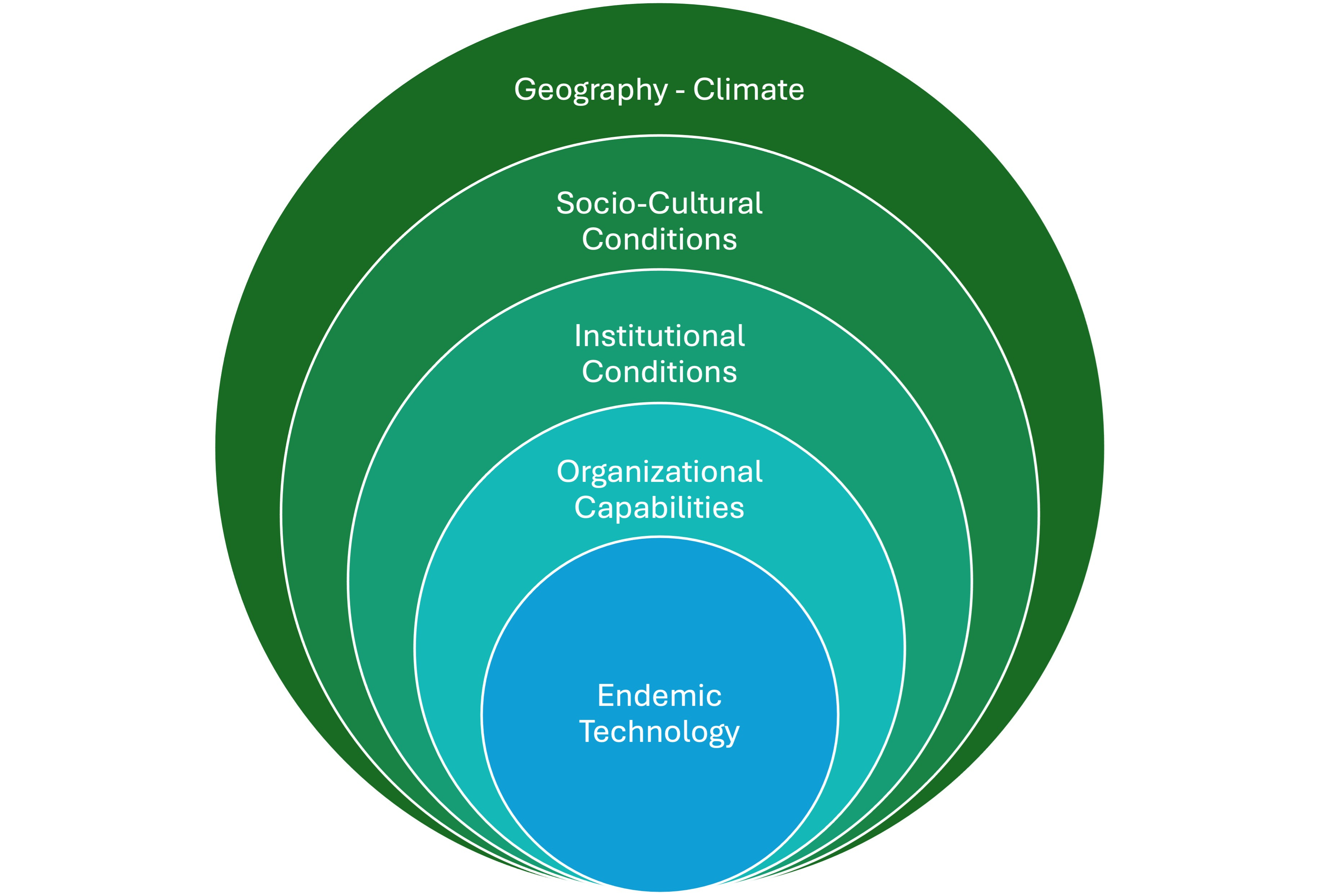
-
Geography and Climate:
Biophysical factors, such as geography, climate, or biodiversity, play a crucial role in endemic innovations by providing the natural conditions and resources that shape and define the type of solutions most likely to emerge from these areas. For example, Norway's intricate fjords create optimal conditions for the development of sustainable salmon farming and the marine bioeconomy. Companies like Cermaq, a global leader in sustainable salmon production and “clean farming”, have leveraged these unique geographic characteristics to develop advanced technological innovations that minimize environmental impact while maximize fish health. A specific example is the use of high-precision sensors to monitor real-time parameters such as dissolved oxygen, water temperature, seabed chemical conditions, and fish density. These technologies optimize farming conditions and reduce environmental risks, positioning Norway as a global benchmark for sustainable aquaculture practices and as the most significant producer of salmon, accounting for 48% of global production.
On the other side of the world, in a culturally and institutionally different country like Chile, a specific region in the southern channels replicates the intricate geography and climate of Norwegian fjords. As a result, the salmon farming industry in Chile took off in the mid-70’s, ultimately positioning the country as the second-largest global player, responsible for 33% of the world’s salmon production. This phenomenon is primarily explained by the biophysical conditions replicated in these two highly specific regions, granting them a structural comparative advantage over other geographies for sustainable salmon production and the development of technological innovations with global impact in this industry.

Cermaq salmon farming facilities in Norway and Chile Analyzing the unique biophysical factors that explain the type of innovations emerging from a specific company in a specific region aligns well with robust management theories such as the Natural Resource-Based View of the Firm (NRBV, Hart, 1994), and the Structural Comparative Advantages (Lin, 2014).
The concept of Endemic Innovation adds additional dimensions to these theories, going beyond the provision of commodities and industrial development strategies in specific countries (Lin), and extends the scope of NRBV, which focuses on pollution prevention, responsible product management, and sustainable development but does not explain the strategic advantages mediated by the contextual and technological singularities examined under the concept of Endemic Innovation.
-
Socio-Cultural Conditions:
History, traditions, ancestral knowledge, and local cultural ethos serve as inexhaustible sources of inspiration for the creation of new products, services, and unique experiences. Within this context, the gastronomic industry—particularly in the realm of haute cuisine—has emerged as a pivotal arena where cultural roots are intertwined with technological sophistication, redefining the dining experience and positioning it as a powerful vehicle for national identity. This phenomenon, a hallmark of human expression since immemorial times, has reached a new zenith on the global stage over the past 30 years.
Peruvian gastronomy stands as a remarkable example of how geographic singularities, unique natural resources, ancestral knowledge intrinsic to the region, and a rich cultural heritage shaped by a complex and fascinating history can culminate in a crucible of endemic innovations with both local and global impact. In this case, the term "endemic gastronomy" may be more appropriate, as Peru has positioned itself in recent years as an international culinary destination of excellence, with Lima even being recognized as the "gastronomic capital of Latin America."
Chef Gastón Acurio is widely regarded as one of the key figures in reigniting Peruvians' pride in their ancestral cuisine and fostering a newfound appreciation for their country. Trained at Le Cordon Bleu in Paris, where he developed his passion for cooking, Acurio returned to Peru in the 90’s and revolutionized Peruvian gastronomy by blending traditional flavors with modern techniques from international haute cuisine. One of Acurio's most emblematic quotes, often repeated in interviews, is: "In the past, children dreamed of becoming soccer players. Now they dream of becoming chefs."
An iconic example of what can be described as Peru’s new "endemic gastronomy" is the restaurant Central (Lima, Peru), founded and led by Chef Virgilio Martínez. Central offers a unique culinary experience that explores Peru’s singular and diverse biodiversity through the concept of "altitudes and ecosystems." Each dish is designed to represent the unique ingredients and flavors of different Peruvian ecosystem, ranging from sea level to the heights of the Andes and the Amazon. This approach deeply connects the restaurant’s value proposal to Peru’s ancestral cultural values and traditions. Among its many accolades, Central has been recognized as the Best Restaurant in Latin America (2022, The World’s 50 Best Restaurants) and the Best Restaurant in the World (2023, The World’s 50 Best Restaurants).
The impact of chefs like Gastón Acurio and Virgilio Martínez extends far beyond the culinary domain (direct impact). Their work has catalyzed growth in related industries, such as gastronomic tourism, agriculture, fishing, and food production (indirect impact). Moreover, their efforts have significantly enhanced Peru’s "nation brand" (induced impact), positioning the country as a cultural and gastronomic beacon, attracting foreign investment, and fostering a virtuous cycle of economic and social development. According to the Peruvian Foreign Trade Society (Comex Perú), this new wave of Peruvian gastronomy—rooted in strong endemic elements—and its associated tourism activities represent approximately 3% of the nation’s GDP.
This case illustrates that recognizing and valorizing a country’s culture and ecological roots constitutes an indispensable strategic asset. For developing nations, such an approach not only fosters sustainable economic growth but also redefines their global positioning as hubs of endemic innovation and cultural excellence.
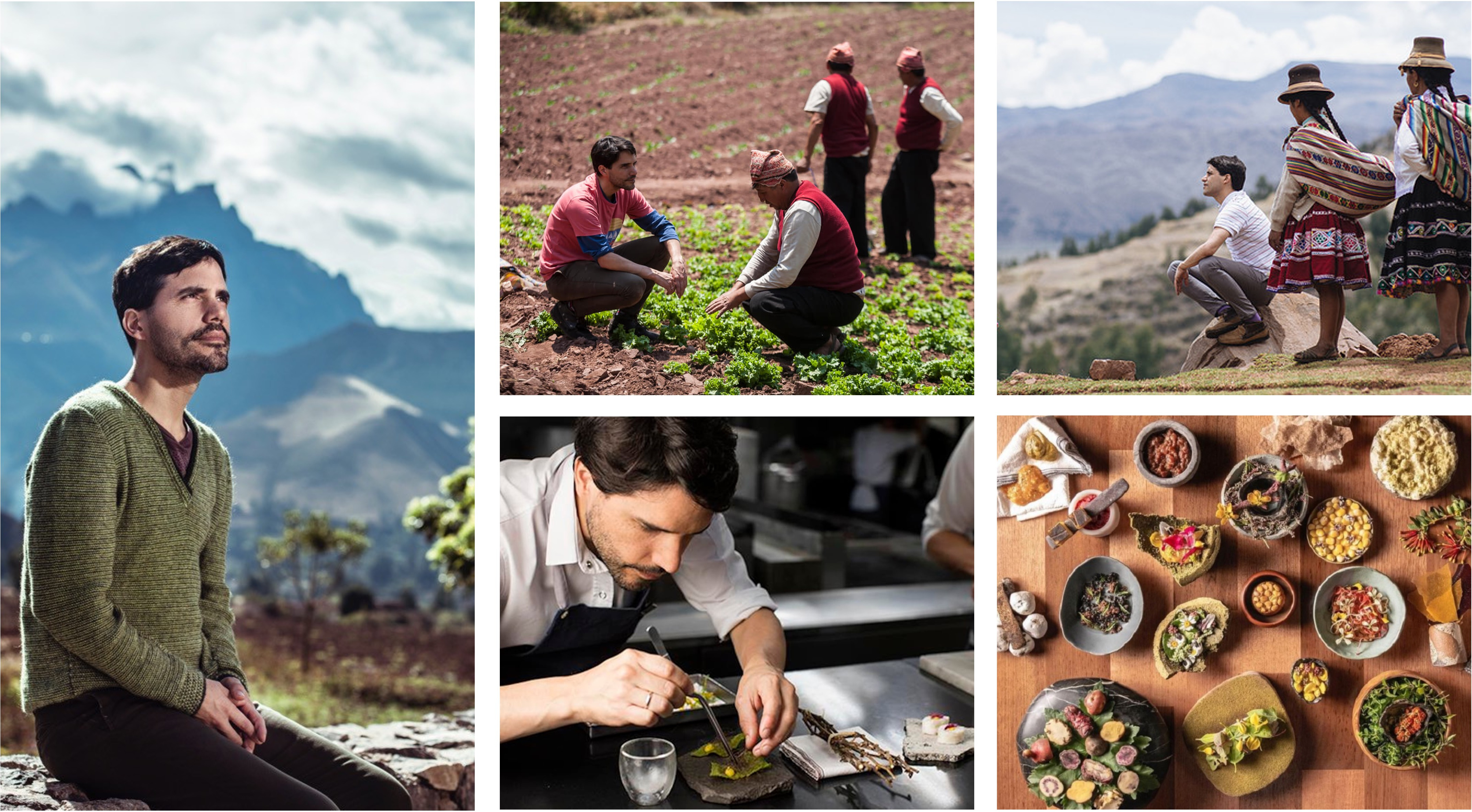
Virgilio Martínez, Chef and Founder of Central Restaurant -
Institutional Conditions:
Institutional stability, public policies, regulatory frameworks, tax incentives, and public- private collaboration networks are pivotal factors that can either accelerate or hinder innovation and economic growth. This premise has been extensively demonstrated by the groundbreaking work of Daron Acemoglu, James Robinson, and Simon Johnson, winners of the 2024 Nobel Prize in Economics.
Their research underscores the critical role of inclusive institutions in fostering innovation ecosystems. Inclusive institutions not only guarantee property rights and enforce contracts but also provide mechanisms to encourage entrepreneurship and technological advancements. Conversely, extractive institutions—characterized by a concentration of power and lack of incentives for innovation—can stifle the capacity for economic transformation. The implications of their findings resonate strongly in the context of developing economies, where institutional dynamics often serve as either a bottleneck or a catalyst for endemic innovation processes.
Countries like Uganda have developed institutional initiatives that foster innovations based on natural resources and ancestral knowledge. A noteworthy example is their focus on alternative uses of bananas, where Uganda ranks as the world’s third-largest producer, following Ghana (2nd) and Cameroon (1st). Historically, bananas have been an integral part of the Ugandan diet, but they also generated vast amounts of waste that were left unutilized. In 2005, the President of Uganda launched the Presidential Initiative on Banana Industrial Development (PIBID) to support this sector by transforming bananas into a strategic resource with value beyond nutrition. The initiative also aimed to create synergies with a range of partners across business, academia, science, private, and public sectors, both within and outside Uganda.
As a result of this presidential initiative, the BanaTex-EA program was created to drive research, development, and production of new textile products made from banana fiber. This program has transformed tons of banana waste into high-quality, sustainable products, offering an innovative alternative to materials like cotton or polyester.
The vision of PIBID is to establish state-of-the-art banana fiber processing plants and companies in Uganda, capable of producing value-added products that are competitive in both local and global markets. These businesses are designed to be led by rural farmers and local entrepreneurs, with full governmental support.

Images from Uganda’s Presidential Initiative on Banana Industrial Development. In stark contrast, Ivory Coast, which produces approximately 45% of the world’s cocoa, could easily position itself as a global leader in the production of high-quality chocolates and other innovations related to cocoa. However, democratic instability, violent ethnic conflicts, and a lack of vision and public policy support for small and medium-sized enterprises have left the country grappling with poverty, child exploitation, and deforestation of its natural resources.
These examples underscore the necessity for nations to align their institutional frameworks with their unique endemic strengths to achieve inclusive economic growth and global competitiveness
-
Organizational Capabilities:
5. Endemic Technology:
Despite the abundance of endemic resources, a company's success largely depends on its ability to transform these resources into innovations that add value and generate positive economic, social, and environmental impact. A company's capacity has been extensively studied by various authors, notably the foundational work of David Teece, Gary Pisano, and Amy Shuen on Dynamic Capabilities (Teece, 1997). A company's capability is therefore based on distinctive internal processes, its portfolio of specific physical and knowledge resources, and the technological evolution trajectories it has adopted. Additionally, an integral approach is required that combines these company-specific assets and competencies with strong leadership with a sustainable strategic vision, while also connecting with specific knowledge of local communities and maintaining an adequate Absorptive Capacity for absorbing exogenous knowledge and technologies (Cohen & Levinthal, 1990). This approach aims to refine, accelerate, enhance, and scale the core “endemic technology”—a concept I will elaborate on in greater detail subsequently.
A paradigmatic example of this synergy of resources and company-level competencies is the Brazilian multinational Natura, a global leader in developing cosmetic, beauty, and hygiene products based on endemic ingredients from the Amazon. Natura has built its business model on a solid commitment to sustainability and bio-innovation, ethically and respectfully leveraging the unique resources of the Amazon. The company not only uses endemic raw materials such as açaí, andiroba, and copaiba essential oils but also invests in advanced research to maximize their potential. To this end, it has implemented innovation laboratories that combine cutting-edge scientific knowledge with traditional resources and insights from local communities, generating unique cosmetic formulas that could not be replicated outside this singular context.
Another distinctive element of Natura is its technological absorptive capacity. The company has integrated advanced technologies to ensure sustainable development processes across its entire value chain, from cultivation to production. This includes utilizing biotechnology and artificial intelligence tools to accelerate research on new molecules, study dermal microbiota (the skin's microorganism ecosystem), apply biomimicry (using nature as product design inspiration), optimize the extraction of active natural compounds, and develop biodegradable packaging—all aligned with its commitment to reducing environmental footprint.
Moreover, Natura has demonstrated exemplary leadership focused on sustainability by collaborating closely with Amazonian communities. Through fair-trade agreements and community education projects, the company has fostered local development, transforming these communities into strategic partners. This collaborative model not only strengthens its supply chain but also reinforces its identity as a sustainability leader, earning it the distinction of being the largest B Corp-certified company in the world and the first publicly traded company to receive this certification.
Thanks to these capabilities, Natura has not only distinguished itself as a leading cosmetic company in its industry but has created a model that redefines the relationship between business, biodiversity, and social development. Its holistic approach to utilizing endemic resources has positioned it as a global reference in sustainable innovation, demonstrating that business success lies in the ability to integrate knowledge, technology, and ethical commitment in a unique environment like the Amazon. Currently, Natura operates across Latin America, the United States, and France, with a portfolio of 1,000 active products, launching approximately 220 new products annually. Its commercial operations leverage an international network of 1.8 million beauty consultants who directly engage with over 100 million customers. The company reported revenues of USD 1,042 Million during the third quarter of 2024, representing an 18.5% increase compared to the same period in 2023 on a constant currency (CC) basis and a 17.4% increase in Brazilian Reals.
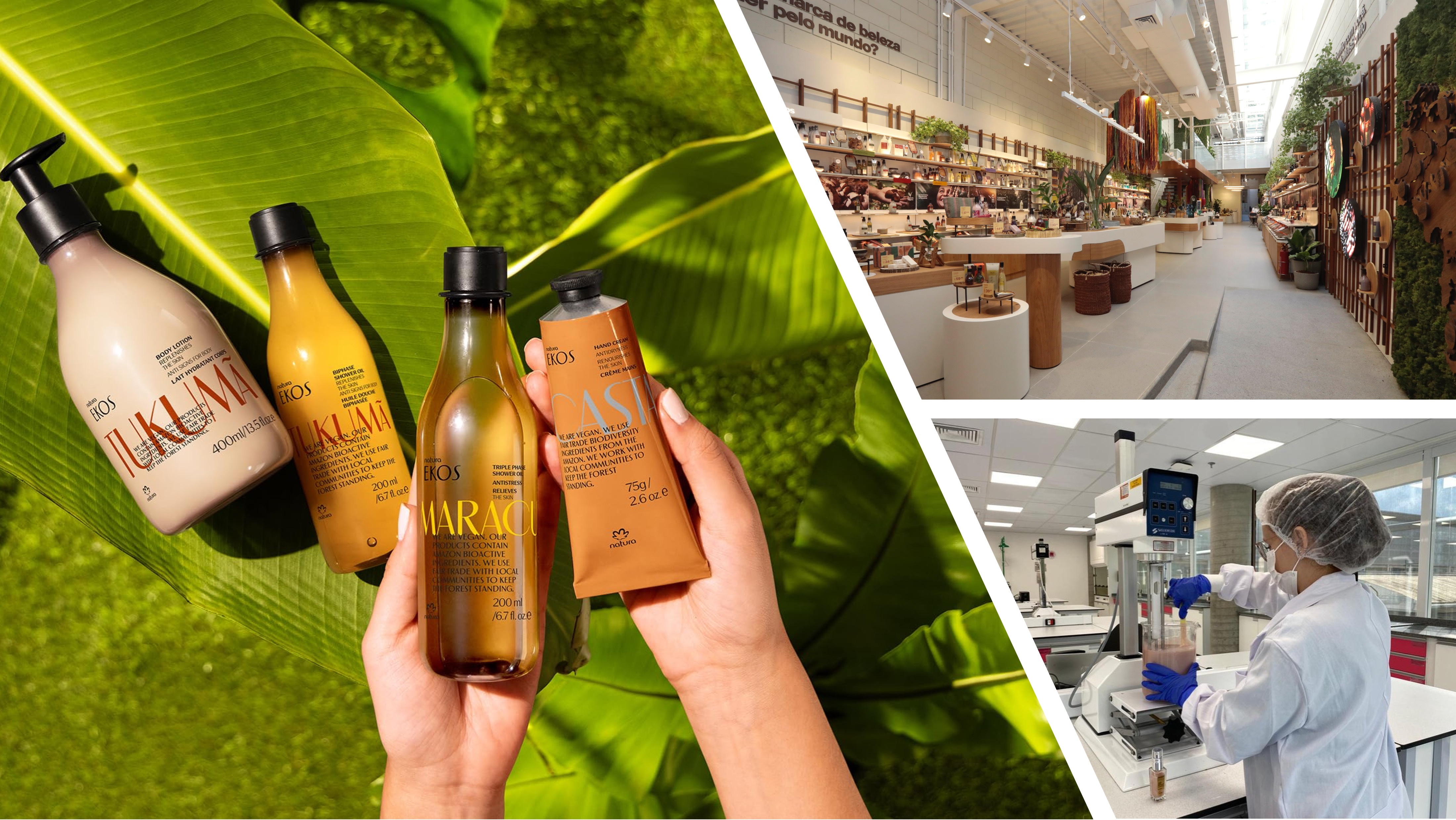
Natura’s products, store and innovation lab. At the core of the Endemic Innovation model lies an advanced knowledge, patent, or technology based on the unique resources and conditions present in a specific region, which I will henceforth call "endemic technology". These endemic technologies are characterized by being highly distinctive and difficult to replicate outside their origin context, providing a significant competitive advantage to the companies that develop them. A recurring pattern in the studied cases is the strategic combination of a base endemic technology with one or more cutting-edge exogenous technologies, such as biotechnology, nanotechnology, artificial intelligence, 3D printing, or robotics, which act as catalysts to refine, transform, enhance, or scale the base endemic technology.
This synergy of technologies is intrinsically related to a fundamental concept in innovation, previously cited in this article: Absorptive Capacity, defined by Cohen and Levinthal (1990) as "the ability to recognize the value of new knowledge (or technologies), acquire, assimilate, and apply it for commercial purposes". Thus, companies leading world-class endemic innovations develop advanced native R&D knowledge, which they combine with exogenous technologies to accelerate and exploit these endemic resources in a unique and highly difficult- to-replicate manner.
This generates a triple competitive advantage, explained by the solution's singularity, the low probability of replicating it in other geographies with different conditions and factors, and a particular combination with a mix of cutting-edge technologies that amplify the impact of the base endemic technology. While the variety of cases exemplifying this pattern is extensive, I will highlight a couple of specific examples that crystallize the concept of "endemic technology", the central axis of the Endemic Innovation model.
Botanical Solution Inc. (BSI) represents an emblematic case of Endemic Innovation by leveraging a unique, endemic natural resource from Chile, the Quillay tree (Quillaja saponaria), to develop innovative, high-added-value products for the pharmaceutical and agricultural industries. Through a patented biotechnological in vitro cultivation and extraction method, BSI produces QS-21, a vaccine adjuvant considered the gold standard for human immune system activation, and Quillibrium®, a highly effective biofungicide that protects fruit and vegetable crops against a variety of pathogens.
This endemic technology combines deep knowledge of Quillay's properties—a native resource from Chilean ecosystems—with advances in biotechnology and their patented plant tissue culture in vitro platform, developed in laboratories in Santiago, Chile, and Davis, California. This approach enables natural resource conservation through sustainable and controlled Quillay cultivation while generating innovative solutions for global challenges in human and plant health. BSI illustrates how the integration of an endemic resource with cutting-edge exogenous technologies leverages structural comparative advantages, solving global problems in a sustainable way, reaffirming the power of the concept of Endemic Innovation.

Quillay tree and BSI’s laboratory facilities.
Bloom represents another outstanding example that transforms a local environmental challenge into a technological and economic opportunity. Based in Mississippi, the company focuses on extracting and processing invasive algae from local aquatic ecosystems, whose uncontrolled growth generates severe ecological imbalances. Through a patented method, Bloom converts these algae into a biodegradable bioplastic with applications across a wide range of products from packaging to sustainable footwear.
This process combines the utilization of an endemic resource (specific invasive algae from local ecosystems) with advanced polymer engineering technologies, resulting in a unique, high-added-value, and environmentally sustainable technology.
Bloom currently has product co-development partnerships with companies like Adidas, Levi's, Puma, and Porsche Design, which are already incorporating these sustainable algae- based biomaterials into their products.
Moreover, Bloom integrates local communities into the collection process, simultaneously generating economic and environmental benefits. This case not only highlights the intelligent use of unique natural resources but also demonstrates how the absorption and utilization of cutting-edge exogenous technologies can transform an environmental problem into a sustainable comparative advantage, becoming a paradigmatic case of Endemic Innovation.
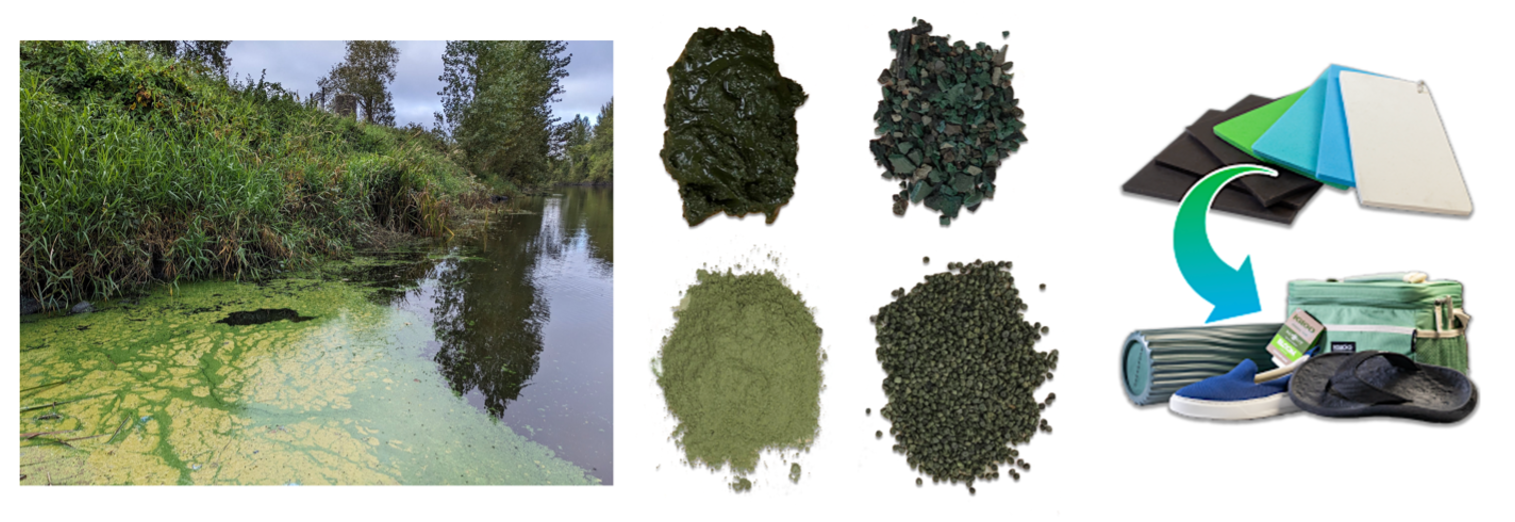
The Bloom’s process, from invasive algae to final products.
The cases of Botanical Solution and Bloom demonstrate the transformative power of Endemic Innovation, where unique regional resources like Quillaja saponaria in Chile or invasive algae in Mississippi become the foundation of endemic technologies generating high-impact solutions across multiple sectors. These examples also illustrate how the strategic combination of endemic and exogenous technologies enables environmental and economic sustainability while positioning companies as industry leaders through comparative advantages difficult to replicate in other contexts.
This analysis reveals that Endemic Innovation is not a fortuitous process but a phenomenon that can be mapped, modeled, and systematized by integrating key elements such as unique natural resources, advanced organizational capabilities, conducive institutional frameworks, and complementary exogenous technologies.
From this point forward, it is crucial to delve into a practical model that explains and systematizes the development and diffusion process of endemic innovations. We will explore the stages and metrics underlying these innovations, from mapping and identifying endemic resources and opportunities to their global scaling and dissemination. This five-stage sequential framework will not only clarify the process but also provide a robust model for future studies and practical applications in the field of endemic innovation.
Model for the Development and Diffusion of Endemic Innovations.
We began with the key conditions and factors necessary for the emergence of endemic innovations. What follows now is to define a clear and sequential process that allows us to clearly explain the stages, activities, and metrics necessary to develop an endemic innovation. The study of international cases of this type of innovation allows us to detect a clear pattern of the process that has been followed, either strategically or tacitly, by many companies that have managed to find a sustainable model based on the unique resources and capabilities of a particular company in a specific region of the world. These defined stages are the following:

1. Mapping and Portfolio of Endemic Opportunities
At the beginning of the endemic innovation development process, a consistent pattern emerges: a refined mapping of endemic opportunities through the identification of unique resources, technologies, or knowledge within the local or regional environment. This step involves conducting a profound immersion in local contexts and communities, systematically observing and studying the geographic, cultural, and social singularities of the region, seeking unique elements that can be transformed into structural comparative advantages.
Some activities to be conducted in this stage include: Mapping potential Natural Laboratories present in the region or country, ethnographic analysis of the historical-cultural context, immersion workshops and information gathering with local communities, and analysis of patterns and correlations between local resources and global trends or needs.
A key guiding question to direct actions in this stage is: "In our region, is there a unique resource that can be transformed into sustainable global value?"
2. Sustainable Strategy Design
After identifying opportunities for developing new endemic technologies with potential applications that address regional or global needs, the process advances towards articulating a clear vision and strategic plan. This includes a comprehensive analysis of potential collaborations with public and private stakeholders through strategic alliances, along with a financing strategy anticipating the capital flows required for developing these solutions.
Additionally, a technological development roadmap is defined, encompassing the articulation of basic science, applied science, and a technology transfer strategy that propels the project to market.
A key guiding question to direct actions in this stage is: "What resources and activities must we articulate to transform our unique resources into a sustainable value proposition, with structural competitive advantages, and regional/global impact?"
3. Technology Absorption and Synergy
A consistent pattern observed in all studied endemic innovations relates to the absorptive capacity concept previously discussed. To enhance the base endemic technology, advanced exogenous technologies such as AI, biotechnology, 3D printing, or robotics must be identified, incorporated, assimilated, transformed, and exploited to build a technological synergy. This allows accelerating, refining, or scaling the base endemic technology, creating a unique combination of endemic and exogenous technologies that constitutes an additional element of differentiation and competitive advantage.
In this stage, a portfolio of potential endemic solutions is also created, which must subsequently be tested to ensure adequate fit with local, regional, or global market demands. Alongside the solutions portfolio, a technological absorption toolkit is recommended to combine, test, and exploit endemic technologies with exogenous technologies at speed. This is an intensive stage in R&D resource utilization, generally requiring strategic alliances with specialized research centers and significant financial resource injection to ensure appropriate technological synergy.
A key guiding question to direct actions in this stage is: "What exogenous technologies can amplify the impact of our endemic resources and technologies?"
4. Technical Validation and Local/Regional Sustainability
The proposed solutions now constitute a portfolio of projects and potential endemic solutions, along with the development of a technological synergy that must be technically, environmentally, and commercially validated in this stage. For these purposes, these incipient solutions undergo an exhaustive prototyping and testing cycle to ensure: correct technology fit (endemic and exogenous), production-environment fit (the productive process minimizes environmental impact), production-community fit (the productive process integrates local communities generating virtuous circles and positive externalities), and solution-market fit (the solution matches real market needs).
Given that this stage involves a comprehensive and multidimensional analysis of the solution's impact, an "endemic innovation index" is proposed to evaluate sustainability, community integration, economic impact, and regional-global scalability potential.
A key guiding question to direct actions in this stage is: "Is this solution sustainable, does it fit local-global market needs, and has potential for scaling?"
5. International Scaling and Diffusion
This is a critical stage where strategies are implemented to bring these solutions to international markets, with the challenges of maintaining cultural identity and ensuring quality replicability in new geographies. A "Diffusion and Scalability Roadmap" is designed to help companies navigate the complex international expansion process. This step includes addressing commercial, legal, logistical, idiomatic, regulatory, and cultural challenges.
Endemic innovation cases that have succeeded internationally demonstrate a strong connection with the "country brand", ensuring a unique cultural identity, national support backing the solution, and a structural comparative advantage of high strategic value in demanding international markets.
A key guiding question to direct actions in this stage is: "How do we maintain quality and cultural authenticity while scaling globally?"
This model not only organizes the endemic innovation process but also provides a practical sequential guide for entrepreneurs, teams, and organizations of all kinds to maximize the potential of their local endemic resources and the likelihood of success in highly competitive markets.
Below is a summary table of the five steps in this process, including key points, actions, and guiding questions for successful progression:
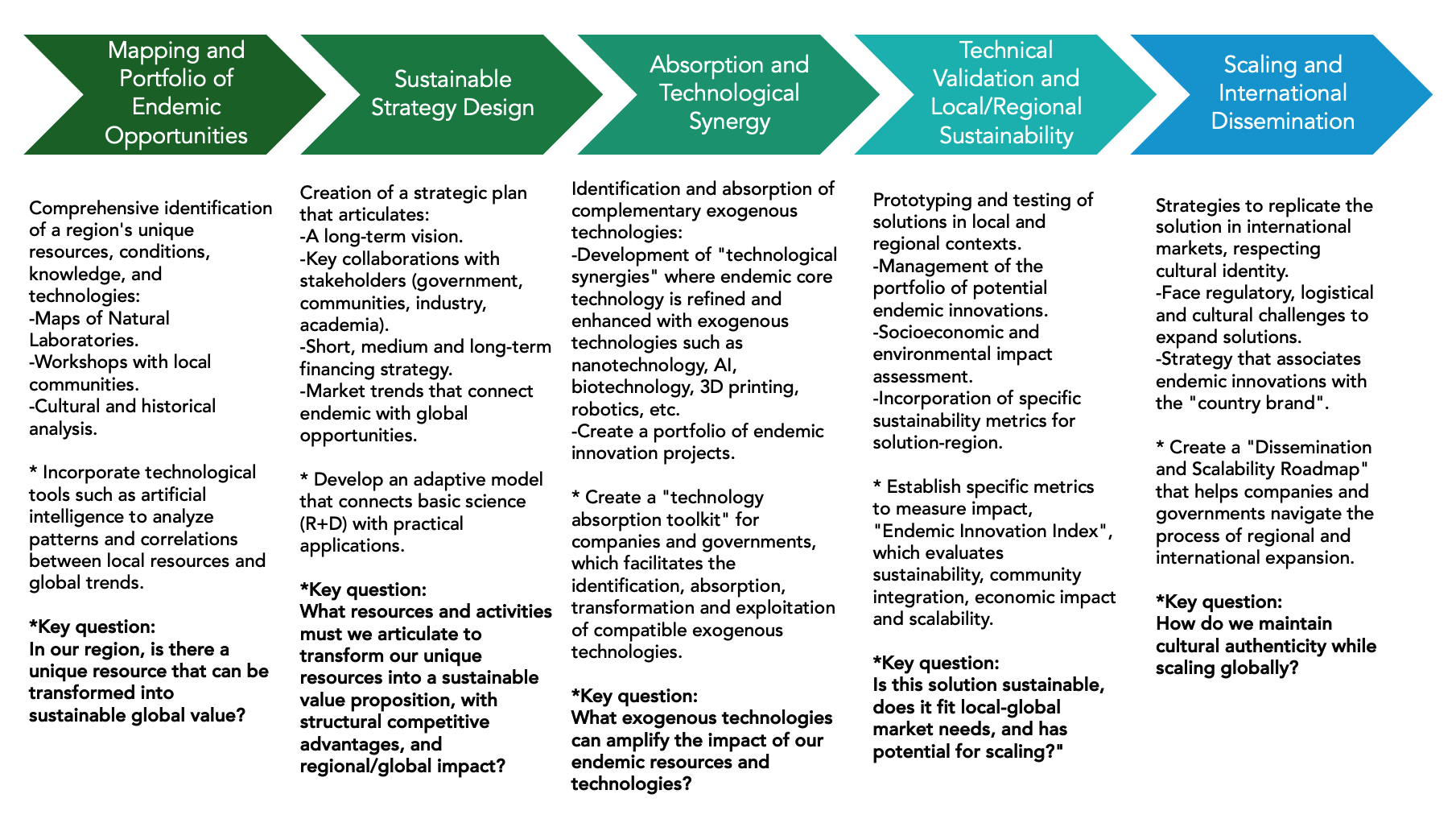
Endemic Innovation Score
In the Endemic Innovation process presented, measuring results is essential to ensure that the initiatives developed are aligned with the strategic objectives of sustainability, technological integration, local impact and global scaling. The metrics associated with each stage allow not only to monitor progress, but also to identify areas for improvement and validate the effectiveness of the endemic approach in different regions and sectors. These metrics are designed to assess critical aspects of each of the stages and allow us to understand in greater detail whether a solution has a weak, medium or strong fit with the concept of endemic innovation.
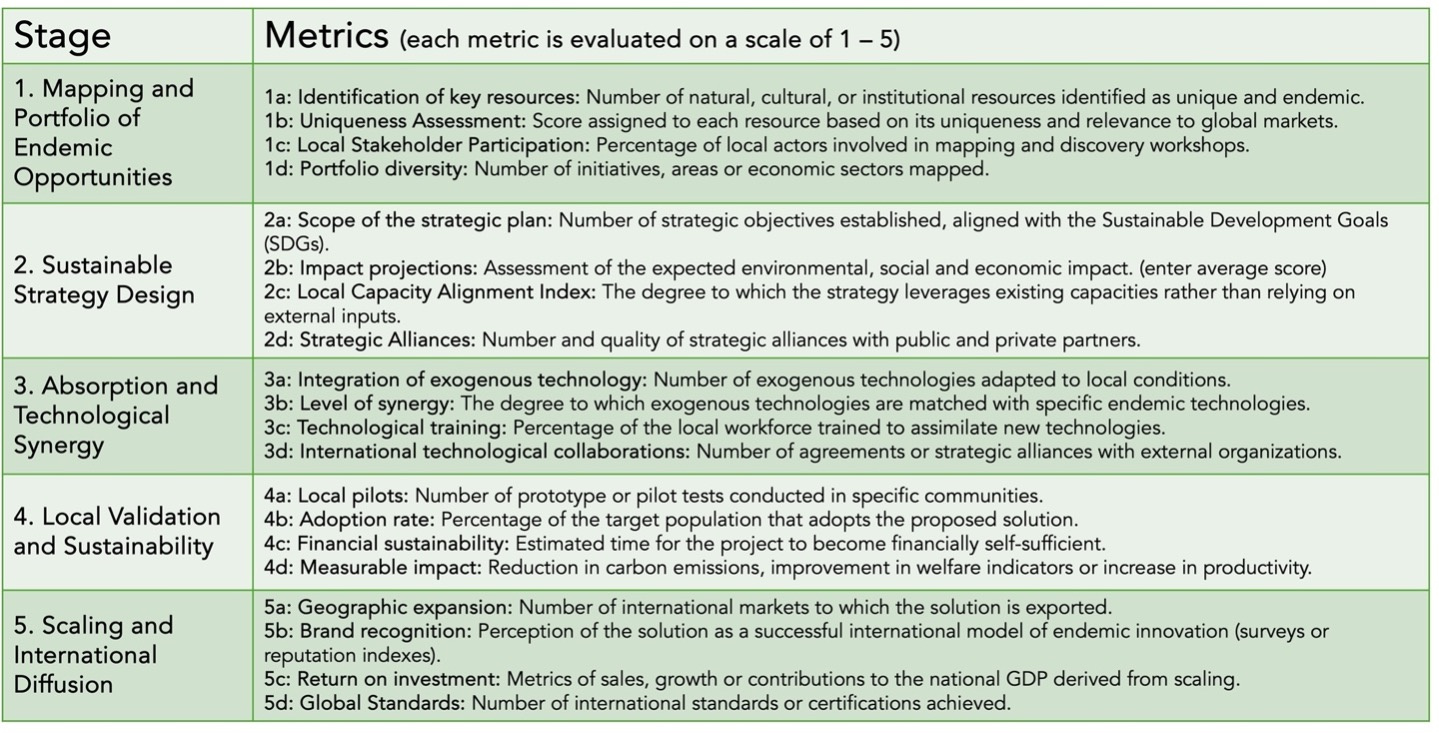
The Endemic Innovation Score evaluation tool operates as a weighting system that measures the performance of an initiative in the five key stages of the process. Each metric proposed for the stages is evaluated quantitatively by assigning a score ranging from 1 to 5, where 1 indicates a low performance and 5 an optimal performance for each metric evaluated. By calculating the weighted average of these metrics, with a weight of 20% assigned to each stage of the process, an Endemic Profile of the evaluated solution is obtained.
This result allows the initiative to be classified on a scale that can be divided into three main categories: Weak Endemic Profile (1 - 2.9), Medium Endemic Profile (3 - 3.9) and Strong Endemic Profile (4 - 5).
To illustrate the profiles that this tool provides, let us consider three examples of initiatives with different endemic development profiles:
- Weak Endemic Profile: A company develops a product based on a natural resource unique to a region, but does not include local actors in the design, nor does it guarantee the economic or environmental sustainability of the solution. Furthermore, it fails to establish functional technological synergies or project its international scaling. In this case, the initiative would obtain low scores in all stages, resulting in a weak profile.
- Medium Endemic Profile: A technological startup that introduces a solution based on a local endemic resource and involves local-regional actors for its validation. However, its strategy lacks a clear international scaling plan, and technological integration is limited to small adaptations without taking full advantage of the potential of the endemic resource or exogenous technology. This case would have strong scores in initial stages such as mapping and local validation, but weak in sustainability and scaling, resulting in a medium endemic profile.
- Strong Endemic Profile: An innovation strongly based on a sophisticated, validated and patented endemic technology, developed in collaboration with local communities that are virtuously incorporated into the business model, designs a sustainable strategy aligned with the Sustainable Development Goals (SDG), integrates advanced exogenous technologies in a functional, novel and high-impact technological synergy. Validate the solution in the local and regional market with positive results and establish international partnerships for its scaling. This balanced and holistic approach would obtain high scores in all stages, representing a strong endemic profile.
These examples illustrate how the tool can be used not only to evaluate initiatives, but also as a strategic guide to optimize each stage of the Endemic Innovation process. By identifying areas of lower performance, organizations can adjust their strategies to strengthen the endemic profile of their solutions, maximizing both their local impact and their global projection. This diagnostic and continuous improvement capacity makes the Endemic Innovation Score a valuable tool to promote initiatives that respond to the needs of sustainability, inclusion and competitiveness in a context of responsible innovation adapted to the unique characteristics of each region.
Conclusion
The endemic innovation model emerges as a novel and differentiating proposal that not only expands the traditional taxonomy of innovation but also broadens the spectrum of possibilities for the development of sustainable solutions with structural comparative advantages, as necessary as they are strategic in today's complex international markets. This approach, which prioritizes the singularities of a particular regional context to unlock value, reconfigures the foundations of innovation theory and practice, proposing a new conceptual and operational framework of great applicability, especially for developing countries.
From a theoretical perspective, endemic innovation represents a paradigmatic evolution of the academic approach to the sources of innovation. It introduces a powerful concept that places the unique and non-replicable characteristics of an environment at the center of strategy. This model is based on solid management theories such as Hart's Natural Resource-Based View of the Firm, Teece's Dynamic Capabilities, Cohen and Levinthal's Absorptive Capacity, and Lin and Chang's Structural Comparative Advantages. Its key contribution lies in generating a new nomenclature that expands traditional innovation concepts, introducing relevant constructs, models and categories to analyze and explain the success of strategies based on unique or difficult-to-replicate local resources and conditions.
Furthermore, the model proposes a critical review of the standardized and generic approaches that predominate in the literature. While conventional innovation tends to prioritize scalable technological solutions without considering territorial or cultural factors, endemic innovation underlines the importance of the unique origin of a technology, tailor-made designs, adapted to specific social, cultural and economic systems. This differentiation amplifies the academic debate on the tension between globalization and localization in the field of innovation.
In practical terms, endemic innovation offers a roadmap for both business managers and public policy makers:
For Managers and Organizational Leaders:
-Identification of distinctive attributes: Managers must carry out a deep diagnosis of the resources and capabilities that are unique to their immediate environment, whether territorial, cultural, technological or social. For example, a company in a developing country could capitalize on traditional artisan skills, combining them with cutting-edge technology to create unique products.
-Co-creation with local communities: The implementation of endemic innovation requires an active commitment to local communities generating virtuous circles and positive externalities. This participatory approach ensures that the results are culturally relevant and sustainable over time.
-Differentiation strategies: By highlighting the endemic as a central attribute, companies and organizations of all kinds can develop inimitable value propositions that allow them to compete in market niches, avoiding the commoditization of their products or services.
For Public Policy Managers:
-Promoting innovation ecosystems: Governments must design ecosystems that favor the sustainable exploitation of endemic resources through tax incentives, subsidies, and public- private partnerships. This approach allows for the development of a roadmap for mapping, developing, and internationalizing untapped endemic opportunities.
-Specialized education and training: It is essential that educational programs include content aimed at valuing local specificities as sources of innovation with structural comparative advantages.
-Internationalization policies: In developing countries, promoting the export of products and services based on endemic innovation can consolidate their position in global markets and generate synergies that enhance the country brand.
Towards Sustainable and Equitable Development
The application of the endemic innovation model has profound implications for shaping national growth strategies, especially in developing countries.
These territories, often marginalized from the benefits of global value chains, can transform their relative disadvantages into comparative advantages by focusing on the valorization of their unique local resources. By prioritizing endemic innovation, countries can move towards more inclusive development models, where the benefits of innovation are not concentrated exclusively in industrialized regions with a high degree of specialization of their national innovation systems.
In conclusion, endemic innovation not only expands the boundaries of academic theory but also offers a pragmatic and transformative approach to address contemporary management and global development challenges. This model invites managers, entrepreneurs, academics, scientists and public policy makers to rethink traditional innovation logics, adopting a more contextualized, collaborative and sustainable perspective. In this way, endemicity is no longer seen as a limitation and becomes the cornerstone of a new era of growth and competitiveness.
Research Context
The concept of Endemic Innovation emerges within the framework of my doctoral research at the Adolfo Ibáñez University (Santiago, Chile) and grounded in intensive observational studies conducted during travels between 2017 and 2023 across world-class innovation ecosystems in countries including the United States, Israel, Netherlands, India, UK, Germany, Spain, Finland, Russia, Dubai, Brazil, Colombia, and Chile. This research is further enriched by my professional experience as co-founder and Chief Innovation Officer of Copper3D (a good example of an endemic innovation), and complemented by a rigorous analysis of over 50 endemic innovation case studies spanning diverse geographical regions such as Asia, South America, Africa, and Oceania. These combined academic and professional experiences enabled the identification of recurring patterns and the development of a robust conceptual framework that serves as the foundational basis for proposing this novel concept and strategic framework approach.
Referenced Management Theories
- Nelson, R. R., & Winter, S. G. (1985). An Evolutionary Theory of Economic Change. Harvard University Press.
- Lin, JY. (2014). New Structural Economics: A Framework for Rethinking Development and Policy. Washington, DC: World Bank, 2012, pp. 371 ISBN 978-0-8213-8955-3
-Hart, S. L. (1994). A natural resource-based view of the firm. Work and Organization Research Centre.
-Teece, D., Pisano, G., Shuen A. (1997). Dynamic Capabilities and Strategic Management. Strategic Management Journal, Vol. 18:7, 509–533
- Cohen, W., Levinthal, D. (1990). Absorptive Capacity: A New Perspective on Learning and Innovation. Administrative Science Quarterly, Vol. 35, No. 1, Special Issue: Technology, Organizations, and Innovation. (Mar., 1990), pp. 128-152.
Follow the Topic
-
Nature

A weekly international journal publishing the finest peer-reviewed research in all fields of science and technology on the basis of its originality, importance, interdisciplinary interest, timeliness, accessibility, elegance and surprising conclusions.

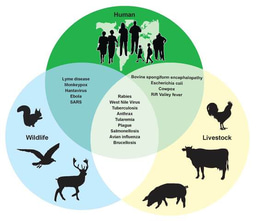
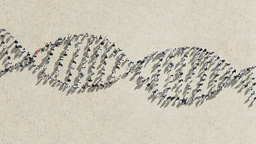

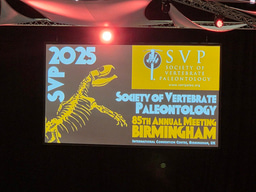
Please sign in or register for FREE
If you are a registered user on Research Communities by Springer Nature, please sign in